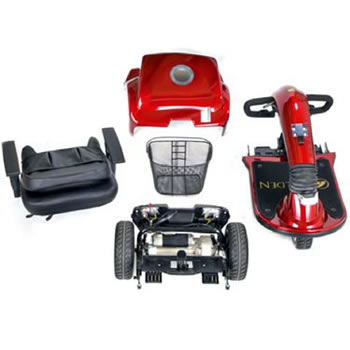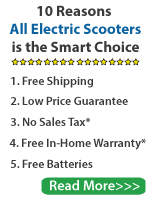 AGM battery: An abbreviation for "absorbent glass mat". These batteries have a high power density and recharge very quickly, making them useful in high-performance electric vehicles.
AGM battery: An abbreviation for "absorbent glass mat". These batteries have a high power density and recharge very quickly, making them useful in high-performance electric vehicles.
Ah: An abbreviation for "ampere-hour" or "amp-hour". The ampere-hour is frequently used in measurements of electrochemical systems such as electrical batteries; different batteries have different Ah ratings.
amp (amperage): The amount of energy an appliance draws from a power source in order to operate. The higher the amperage of a given device, the faster it will consume a given amount of energy.
armrest: These pieces are attached to either side of the scooter's seat and provide support for the user's arms while steering. Most armrests are designed to lift or detach, allowing the user to safely transfer from the scooter seat to a wheelchair. Many electric scooter accessories attach to the armrest.
Comfort Ride seat suspension: Comfort Ride seats feature a maintenance-free air-suspension pedestal. Drivers can use a fingertip control to adjust ride and height, and position their bodies directly over the suspension with a double-locking pedestal slide.
controller: A device which manages the distribution of power from the electric scooter battery to the various electrical components of a scooter. When replacing a controller on your electric scooter, it is very important that you obtain a controller with the proper voltage for your scooter model. Contact the manufacturer or consult your owner's manual to obtain this information.
delta tiller: A roughly ovular steering handle which allows a person with limited manual dexterity, such as from loss of motor coordination due to a stroke, to steer a mobility scooter with greater ease.
drive chain or drive belt: A strip of rubber or interlocked metal pieces which works in conjunction with the motor and axle to propel the scooter forward or backward.
drive train: Typically, this term refers to the transaxle and motor when discussing electric scooters. Bear in mind, though, that some manufacturers will distinguish between the drive train and the motor for warranty purposes.
dual braking system: A brake system in which there is a separate brake for the front tires and the back tires.
Electronic Speed Control: An electronic circuit that varies the speed of an electric motor, and sometimes is also configured to act as a dynamic brake.
EZ Reach Tiller: A steering tiller which is equipped with a lever which allows the tiller to be adjusted to suit the scooter driver's height and hand angle for safe operation.
frame: The main underlying structure of an automotive device such as a car or scooter. The wheels, motor, and body are all mounted to the frame, which must be strong enough to support the weight of the attached components.
ground clearance: The amount of space between the bottom of the scooter and the ground beneath it. The higher the ground clearance, the better a scooter will perform on rough or uneven terrain.
LED lights: An abbreviation for light-emitting diode. Despite being brighter than incandescent light sources, LED lights use less energy and output less heat than incandescent lights, and can emit light over the visible, infrared, and ultraviolet wavelength spectrums.
LiquiCell equipped seats: Seats which are padded with a liquid-filled material which relieves pressure, friction, and discomfort while seated.
Mag Wheels: “Mag” is short for magnesium alloy. Magnesium alloy wheels are more lightweight than steel and aluminum wheels, allowing for higher speeds and more energy-efficient motor operation.
maximum distance per charge: A measurement of how far a given scooter can travel on a fully charged battery before it completely runs out of power, usually expressed in miles.
motor/electronics: Some scooter manufacturers offer warranty coverage on the motor and electronic components of the scooter, including electronic controllers and chargers. Bear in mind that this warranty coverage does not apply to batteries, motor brushes, or other disposable parts which experience normal wear and tear and must eventually be replaced due to use.
offboard battery charger: A charge station for a which is not housed on the scooter that the battery powers. To use such a charger, the battery must be removed from the scooter and plugged into the charger.
onboard battery charger: A charger which is housed on the scooter, and usually permanently attached to the battery, so that the battery can be recharged simply by plugging the scooter charger into a wall outlet.
operating range: See maximum distance per charge.
personal mobility vehicle (PMV): A term used to describe heavy duty luxury scooters. Examples include the Golden Avenger, the Pride Wrangler and the Pride Pursuit.
pneumatic tires: Traditional inflatable tires, much like you would use on your bicycle or automobile.
puncture proof tires: Also referred to as solid tires or flat-free tires, puncture proof tires are made of heavy plastic or solid rubber to protect against wear. Unlike pneumatic (inflatable) tires, puncture-proof tires won't go flat if a user runs over something sharp with their scooter.
regenerative brakes: These types of brakes absorb the kinetic energy created by braking and convert them into usable energy instead of heat as conventional brakes do, usually rerouting this energy to a battery.
SLA battery: Shorthand for sealed lead acid battery, of which gel batteries are a subtype. All gel batteries are considered SLA batteries, but not all SLA batteries are necessarily gel batteries.
shroud: An industry term for the cosmetic covering that protects the body of the scooter from exposure to the elements.
solid tires: Also known as flat-free tires, these tires are made of highly durable polyurethane foam or plastic. Because they do not have the tubing and soft rubber exterior of a pneumatic tire, they are highly resistant to wear and can't be rendered useless by a puncture.
throttle: More appropriately called a thrust lever, the throttle on an electric mobility scooter acts much like the gas pedal on a standard automobile, increasing speed as the throttle is pushed.
tiller: A steering bar which is used to rotate the wheels left and right while driving a scooter. The term originates from nautical phraseology - tiller bars are often used to control directional rudders on boats. Many mobility scooters feature a wraparound, or Delta, tiller, which is shaped like a rounded-off rectangle to allow the user to steer the scooter using a variety of hand and wrist positions (this is useful for someone with limited manual dexterity). Other scooter models have adjustable tillers, allowing you to adjust the height and angle of the steering bar to the configuration you desire.
turning radius: The distance required for a scooter to completely turn around 180 degrees. Generally, the smaller the scooter, the smaller its turning radius. 3 wheel scooters also tend to have smaller turning radii than 4 wheel scooters do.
weight capacity: The maximum load that a scooter can safely carry, usually expressed in pounds. Travel scooters usually have relatively low weight capacities; heavy duty scooters have the highest weight capacities.





